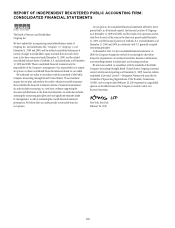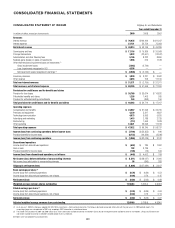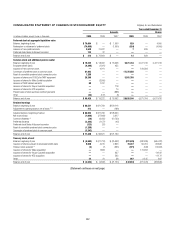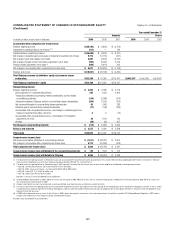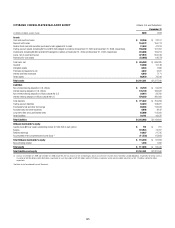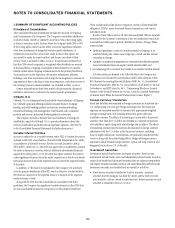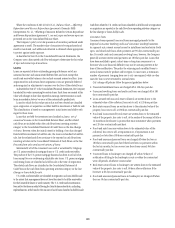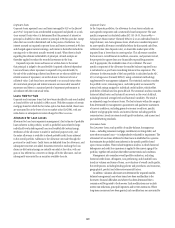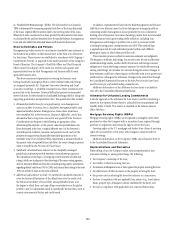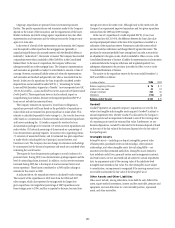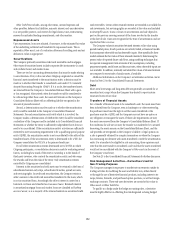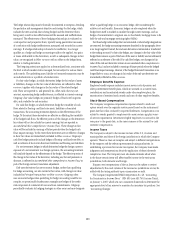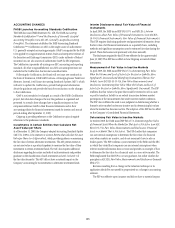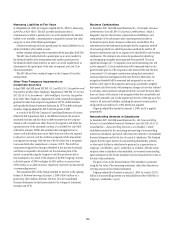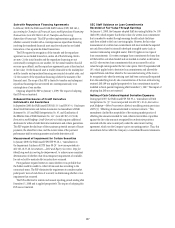Citibank 2009 Annual Report Download - page 138
Download and view the complete annual report
Please find page 138 of the 2009 Citibank annual report below. You can navigate through the pages in the report by either clicking on the pages listed below, or by using the keyword search tool below to find specific information within the annual report.128
Where the conditions of ASC 210-20-45-11, Balance Sheet—Offsetting:
Repurchase and Reverse Repurchase Agreements (formerly FASB
Interpretation No. 41, “Offsetting of Amounts Related to Certain Repurchase
and Reverse Repurchase Agreements”), are met, repos and reverse repos are
presented net on the Consolidated Balance Sheet.
The Company’s policy is to take possession of securities purchased under
agreements to resell. The market value of securities to be repurchased and
resold is monitored, and additional collateral is obtained where appropriate
to protect against credit exposure.
As described in Note 26 to the Consolidated Financial Statements, the
Company uses a discounted cash flow technique to determine the fair value
of repo and reverse repo transactions.
Loans
Loans are reported at their outstanding principal balances net of any
unearned income and unamortized deferred fees and costs except that
credit card receivable balances also include accrued interest and fees. Loan
origination fees and certain direct origination costs are generally deferred
and recognized as adjustments to income over the lives of the related loans.
As described in Note 27 to the Consolidated Financial Statements, the Company
has elected fair value accounting for certain loans. Such loans are carried at fair
value with changes in fair value reported in earnings. Interest income on such
loans is recorded in Interest revenue at the contractually specified rate.
Loans for which the fair value option has not been elected are classified
upon origination or acquisition as either held-for-investment or held-for-sale.
This classification is based on management’s initial intent and ability with
regard to those loans.
Loans that are held-for-investment are classified as Loans, net of
unearned income on the Consolidated Balance Sheet, and the related
cash flows are included within the cash flows from investing activities
category in the Consolidated Statement of Cash Flows on the line Change
in loans. However, when the initial intent for holding a loan has changed
from held-for-investment to held-for-sale, the loan is reclassified to held-for-
sale, but the related cash flows continue to be reported in cash flows from
investing activities in the Consolidated Statement of Cash Flows on the line
Proceeds from sales and securitizations of loans.
Substantially all of the consumer loans sold or securitized by Citigroup
are U.S. prime residential mortgage loans or U.S. credit card receivables.
The practice of the U.S. prime mortgage business has been to sell all of its
loans except for non-conforming adjustable rate loans. U.S. prime mortgage
conforming loans are classified as held-for-sale at the time of origination.
The related cash flows are classified in the Consolidated Statement of
Cash Flows in the cash flows from operating activities category on the line
Change in loans held-for-sale.
U.S. credit card receivables are classified at origination as loans-held-for-sale
to the extent that management does not have the intent to hold the receivables
for the foreseeable future or until maturity. The U.S. credit card securitization
forecast for the three months following the latest balance sheet date, excluding
replenishments, is the basis for the amount of such loans classified as held-for-sale.
Cash flows related to U.S. credit card loans classified as held-for-sale at origination
or acquisition are reported in the cash flows from operating activities category on
the line Change in loans held-for-sale.
Consumer loans
Consumer loans represent loans and leases managed primarily by the
Regional Consumer Banking and Local Consumer Lending businesses.
As a general rule, interest accrual ceases for installment and real estate (both
open- and closed-end) loans when payments are 90 days contractually past
due. For credit cards and unsecured revolving loans, however, the Company
generally accrues interest until payments are 180 days past due. Loans that
have been modified to grant a short-term or long-term concession to a
borrower who is in financial difficulty may not be accruing interest at the
time of the modification. The policy for returning such modified loans to
accrual status varies by product and/or region. In most cases, a minimum
number of payments (ranging from one to six) are required, while in other
cases the loan is never returned to accrual status.
Citi’s charge-off policies follow the general guidelines below:
Unsecured installment loans are charged off at 120 days past due. •
Unsecured revolving loans and credit card• loans are charged off at 180
days contractually past due.
Loans secured with non-real estate collateral are written down to the •
estimated value of the collateral, less costs to sell, at 120 days past due.
Real estate-secured loans are written down to the estimated value of the •
property, less costs to sell, at 180 days contractually past due.
Non-bank loans secured by real estate are written down to the estimated •
value of the property, less costs to sell, at the earlier of the receipt of title or
12 months in foreclosure (a process that must commence when payments
are 120 days contractually past due).
Non-bank auto loans are written down to the estimated value of the •
collateral, less costs to sell, at repossession or, if repossession is not
pursued, no later than 180 days contractually past due.
Non-bank unsecured personal loans are charged off when the loan is •
180 days contractually past due if there have been no payments within
the last six months, but in no event can these loans exceed 360 days
contractually past due.
Unsecured loans in bankruptcy are charged off within 30 days of •
notification of filing by the bankruptcy court or within the contractual
write-off periods, whichever occurs earlier.
Real estate-secured loans in bankruptcy are written down to the estimated •
value of the property, less costs to sell, 60 days after notification if the
borrower is 60 days contractually past due.
Non-bank unsecured personal loans in bankruptcy are charged off when •
they are 30 days contractually past due.


